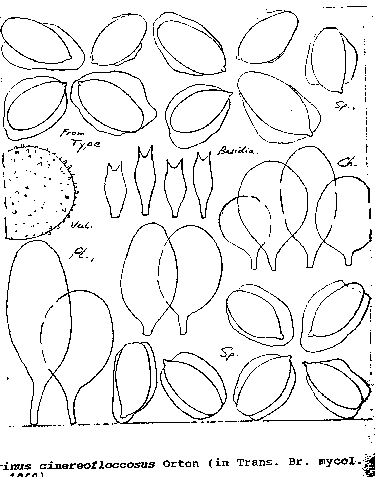Macroscopic features |
Pileus up to 22 x 20 mm when still closed, up to 35 mm when expanded, subglobose to oblong, densely covered with mealy to hairy floccose veil, first greyish white, then pale grey to mouse grey. Lamellae free, white to black. Stipe 30-60 x 2-4 mm, whitish; base somewhat clavate. Smell none. |
Microscopic features |
Spores 11.6-14.0 x 5.7-7.5 µm, Q = 1.75-2.15, av. Q = 1.90-2.00, av. L = 12.9-13.0 µm, av. B = 6.5-6.6 µm, ellipsoid or ovoid, with conical base and rounded apex, dark red-brown; germ pore central, 1.5-1.8 µm wide; episporium smooth, up to 2 µm wide in places. Basidia 20-32 x 8-9.5 µm, 2-spored, surrounded by 3-6 pseudoparaphyses. Pleurocystidia 50-120 x 22-40 µm, utriform, oblong or subcylindric. Cheilocystidia 30-90 x 20-45 µm, (sub)globose, ellipsoid, oblong, utriform or subcylindric. Pileipellis made up hyphoid elements. Elements of veil up to 80 µm wide, made up of globose, warty cells connected with narrow, diverticulate hyphae. Clamp-connections not found. |
Habitat & distribution |
Very rare, terrestrial among grasses. Known from England and The Netherlands. |
Remarks |
The spores with conical base distinguish Coprinus cinereofloccosus from the close related and also 2-spored species C. saccharomyces, which have broader spores with rounded base. |

[Copyright © by ]